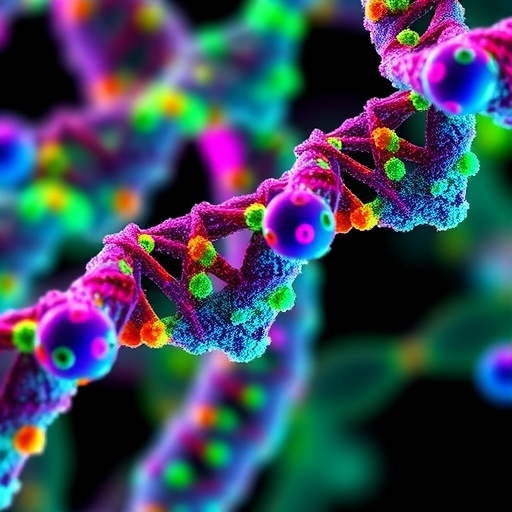Researchers pushing the boundaries of microscopy have recently been introduced to an innovative tool that promises to enhance both fluorescence microscopy and electron microscopy (EM) workflows. This groundbreaking protocol centers around genetically encoded EMcapsulin reporters, which offer a multifaceted approach to visualizing cellular components with unprecedented accuracy and clarity. Scientists, regardless of their prior experience with electron microscopy, now have access to a comprehensive guide that demystifies the process, allowing for effective use and application of these EMcapsulins in their studies.
The versatility of EMcapsulins lies in their modular design, enabling researchers to tag specific proteins or cellular structures. When expressed in cell cultures or within model organisms, these clever gene reporters manifest as distinct morphological shapes observable under electron microscopy. This unique feature not only assists in the accurate identification of cellular components but also opens doors to novel experimental possibilities. As scientists continue to explore the microscopic world, the incorporation of EMcapsulins represents a significant advancement in the visualization toolkit available to biologists.
One of the protocol’s key strengths is its detailed step-by-step guidance for labeling cells or proteins of interest using fluorescent EMcapsulins. The process outlined in the protocol is designed to be user-friendly, ensuring that even those with limited experience in electron microscopy can navigate it effectively. Through clear instructions and illustrations, researchers can ensure high fidelity in the labeling process, ultimately leading to more reliable and reproducible results in their experiments.
In addition to labeling techniques, the protocol emphasizes the importance of biochemical quality control measures. Proper quality control is crucial in experiments involving genetically encoded reporters, as it guarantees the integrity of the data being collected. The authors meticulously outline the various quality measures necessary to check for the accuracy of the tags, the efficiency of the labeling process, and the overall viability of the cells or proteins involved. Such stringent control mechanisms help to instill confidence in the findings derived from studies utilizing these innovative reporters.
As part of the protocol, researchers are encouraged to personalize their experiments by adapting the EMcapsulin constructs for specific needs. The adaptability of these constructs allows teams working on diverse projects—be it disease modeling, developmental biology, or cell signaling—to tailor their EMcapsulin usage. By customizing the constructs, scientists can enhance the relevance of their experiments, which may lead to new insights and discoveries in their respective fields.
Furthermore, the multi-channel capabilities of EMcapsulins represent a leap forward in microscopy technology. With the ability to visualize multiple targets simultaneously, researchers can gather richer data sets within a single experimental framework. This multiplexing aspect allows for the investigation of complex interactions within cells, giving scientists a broader understanding of cellular dynamics. It encourages the exploration of previously hard-to-study biological phenomena, ultimately contributing to the advancement of scientific knowledge.
The potential applications for the EMcapsulin reporters are vast, extending beyond basic research into therapeutic and clinical settings. For example, in the realm of cancer research, these reporters could be harnessed to track tumor cells and investigate their interactions with the surrounding microenvironment. Moreover, in developmental biology, themed studies involving organogenesis can greatly benefit from the enhanced visualization capabilities provided by these innovative constructs, helping researchers to visualize the intricate processes occurring during development.
As science begins to fully embrace the advantages offered by EMcapsulins, researchers are calling for additional studies to further refine and validate the protocol. Collaborative efforts across laboratories could amplify the potential of these genetic tags, providing a robust platform for collective advancements. By sharing variations of EMcapsulin constructs and findings, the scientific community can foster a culture of innovation, inspiring new research ideas that build upon the foundational knowledge established by this protocol.
However, while the protocol provides an efficient framework, researchers must remain mindful of the limitations inherent to fluorescent and electron microscopy techniques. Factors such as sample preparation, imaging conditions, and data interpretation all play a role in the success of any microscopy-based study. It is crucial that scientists remain vigilant, continuously evaluating their methods and findings to overcome potential challenges.
Ultimately, the introduction of EMcapsulins presents a significant leap forward in the realm of microscopy, providing researchers with powerful tools for visualization. With comprehensive guidance offered in the new protocol, biologists can elevate their experimental designs, enabling them to uncover novel insights about cellular processes. As scientists continue to explore the bio-molecular landscape, the integration of these state-of-the-art genetic reporters promises to catalyze innovation, allowing for a richer understanding of the cellular world.
With the potential for groundbreaking discoveries on the horizon, researchers and innovators alike are closely watching the field’s advancements. EMcapsulin technology could potentially pave the way for a new era in microscopy, where visualizing the complexity of life at the cellular level becomes easier and more nuanced. As studies utilizing these techniques begin to emerge, the scientific community anticipates transformative insights that could impact fields ranging from basic biology to applied medical sciences.
In closing, the protocol for genetically encoded EMcapsulin reporters offers researchers an exciting opportunity to enhance their microscopy workflows. By combining the creativity of genetic engineering with robust imaging methods, scientists stand at the forefront of a revolution that promises to unlock the mysteries of life on a molecular scale. The future of microscopy looks bright, and EMcapsulins may well be one of the key players in shaping the landscape of scientific discovery moving forward.
Subject of Research: Genetically Encoded EMcapsulin Reporters
Article Title: Multiplexed genetic tags for electron and fluorescence microscopy
Article References:
Berezin, O., Piovesan, A., Graf, R. et al. Multiplexed genetic tags for electron and fluorescence microscopy. Nat Protoc (2025). https://doi.org/10.1038/s41596-025-01260-7
Image Credits: AI Generated
DOI: https://doi.org/10.1038/s41596-025-01260-7
Keywords: EMcapsulins, electron microscopy, fluorescence microscopy, genetic reporters, multiplexing, cellular visualization, quality control, research protocol.




